Table of Contents
What is a Food Chain?
A food chain refers to the sequence of events in an ecosystem in which one living organism consumes another, which is then consumed by a larger organism. A food chain is the movement of nutrients and energy from one creature to another at different trophic levels.
- A food chain describes which organisms consume which others in the environment.
- The food chain is a straight succession of creatures in which nutrients and energy are passed from one to the next.
- This takes place when one creature swallows another.
- The process begins with the producer organism and concludes with the decomposer organism.
- After understanding the food chain, we realise that the life of one organism depends on that of another.
- The food chain also explains the feeding relationship or pattern between living species.
- Trophic level refers to the sequential phases in a food chain, beginning with producers and progressing upwards to primary, secondary, and tertiary consumers.
- Each level of a food chain is referred to as a trophic level.
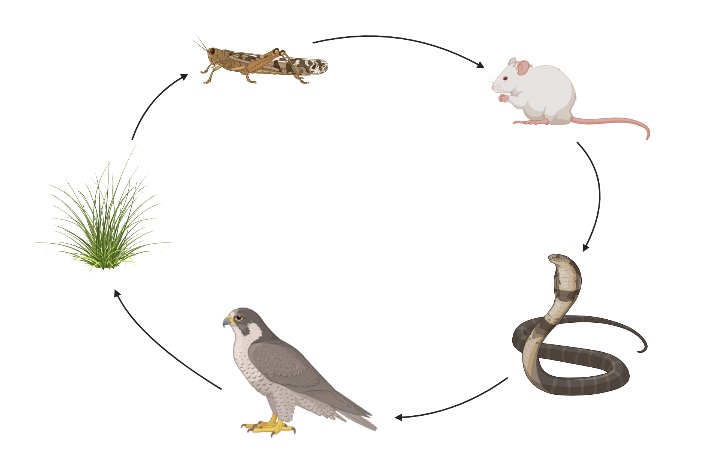
Features of Food Chain
- Most food chains start with the producers. Organisms that make their own food are called producers. Plants, phytoplankton, and organisms that look like plants, like algae, are all examples of producers. The food chain starts when these producers are eaten by other organisms.
- Some producers, like plants, get the energy they need to make food from the sun. Photosynthesis is the name for this process. There are some producers who use chemical energy to make their food, but most producers need sunlight to make their food.
- The energy that is passed along a food chain as one organism eats another is made by producers, which have the unique ability to turn inorganic compounds into organic compounds. All living things on Earth depend on this.
- Consumers are the organisms that eat the producers. Herbivores, carnivores, and omnivores are the three types of eaters. Herbivores only eat plants, carnivores only eat animals, and omnivores can eat both plants and animals. Some animals hunt live animals to eat, while others only eat dead animals. The animals that only eat dead animals are called scavengers.
- Lions, tigers, sharks, and eagles are all examples of carnivores. Cows, sheep, rabbits, zebras, antelope, and giraffes are all herbivores. People, bears, pigs, and dogs are all examples of omnivores. Raccoons, hyenas, and vultures are all examples of scavengers.
- Another important part of the food chain is another kind of living thing. These are decomposers, which eat dead organic matter and break it down to make soil. Without decomposers, many ecosystems would not exist. This is because plants get nutrients from the soil, which starts the process over again. There are more than 100,000 different kinds of decomposers, such as bacteria, fungi, and worms.
- Depending on the environment in which they live, food chains can be long or short. But if a food chain is too long, the energy that gets passed along will be less useful to the animal at the end of the chain because some energy is lost at each step.
- In the 10th century, a scientist and philosopher named Al-Jahiz came up with the idea of the food chain. In 1927, Charles Elton wrote a book that popularised Al-ideas Jahiz’s and also came up with the idea of the food web. A food web shows how all the food chains in a certain area connect to each other.
- Some of the most unusual food chains in the world are those of the Brazilian maned wolf, which eats mostly plants and fruit, and the Blue Whale, which is the biggest animal in the world but only eats krill, a tiny sea creature that looks like a small shrimp.
- People are at the bottom of the food chain because they eat both plants and animals and don’t have any natural enemies.
Parts of Food Chain
The food chain includes four major components:
- The Sun: Everything on Earth gets its energy from the sun, which is the first source of energy.
- Producers: Phytoplankton, cyanobacteria, algae, and green plants are all examples of producers in a food chain. This is the first link in a chain of food. The first step in a food chain is the producers. The farmers make food by using the energy from the sun. Autotrophs are another name for producers because they make their own food. Producers are plants and other living things that make their own food through a process called photosynthesis.
- Consumers: Consumers are all organisms that get their food from plants or other animals. This is the biggest part of a food web because almost every living thing is in it. It includes herbivores, which are animals that eat plants, carnivores, which are animals that eat other animals, parasites, which live off of other organisms by hurting them, and scavengers, which are animals that eat dead animals.
- Decomposers: Decomposers are living things that get their energy from dead or old organic matter. In a food chain, this is the last step. Decomposers are an important part of the food chain because they turn organic waste into inorganic waste, which adds nutrients to the soil or land. Decomposers finish a cycle of life. They help recycle nutrients because they add nutrients to the soil or oceans that autotrophs or producers can use. So, a whole new food chain began.
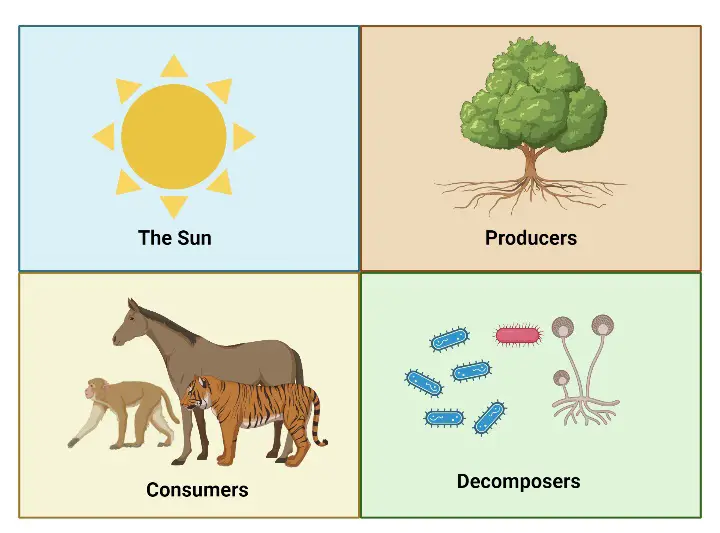
In this case, herbivores are called “primary consumers,” while carnivores are called “secondary consumers.” Organisms that eat producers make up the second level of the food chain. So, the second trophic level is made up of organisms that are primary consumers or herbivores.
Food chains Description
Now we can look at how energy and nutrients move through a community of living things. Let’s start by looking at a food chain to see a few examples of who eats who.
A food chain is a line of organisms where nutrients and energy move from one to the next as one eats the other. Let’s look at the different parts of a typical food chain, starting with the producers at the bottom and working our way up.
- The first producers are at the bottom of the food chain. Autotrophs are the main producers, and they are usually photosynthetic organisms like plants, algae, and cyanobacteria.
- Primary consumers are the organisms that eat the primary producers. Most of the time, the main food source for herbivores is plants, but they may also eat algae or bacteria.
- Secondary consumers are the things that eat the primary consumers. Most secondary consumers are carnivores, or people who eat meat.
- Tertiary consumers are the organisms that eat the second-level consumers. Like eagles or big fish, these are carnivores that eat other meat.
- Some food chains have more steps, like when carnivores eat tertiary consumers. This is called a quaternary consumer. Apex consumers are the organisms at the top of a food chain.
In the diagram below, we can see what some of these levels look like. Green algae are the main source of food for mollusks, which are the main consumers. The mollusks are then eaten by the slimy sculpin fish, which is a secondary consumer. The slimy sculpin fish is then eaten by the Chinook salmon, which is a third-tier consumer.
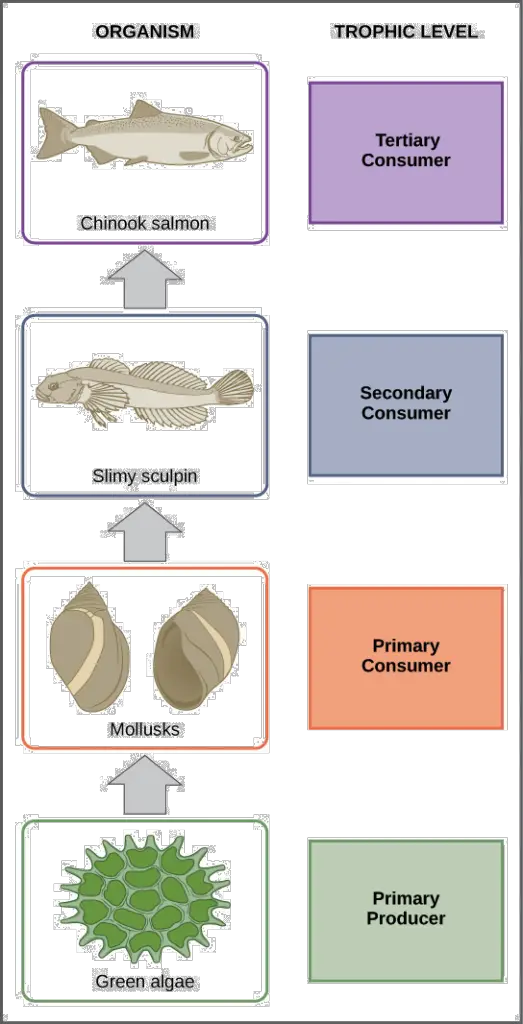
Each of the above groups is called a “trophic level,” and it shows how many energy and nutrient transfers, or “consumption steps,” are between an organism and the energy source that started the food chain, such as light. As we’ll see below, it’s not always easy to put organisms in the right trophic level. People are omnivores, which means they can eat both plants and animals.
What is Food Web?
- A food web is made up of many food chains that are linked together.
- A food web is similar to a food chain, but it’s much bigger than a food chain.
- Sometimes, a single organism is eaten by a lot of predators, or it eats a lot of other organisms. Because of this, a lot of trophic levels become linked.
- The food chain doesn’t show how energy moves in the best way. But the food web is able to show how energy flows because it shows how different organisms interact with each other.
- The food web gets more complicated when there are more interactions between different food chains. The more complicated a food web is, the more stable it is.
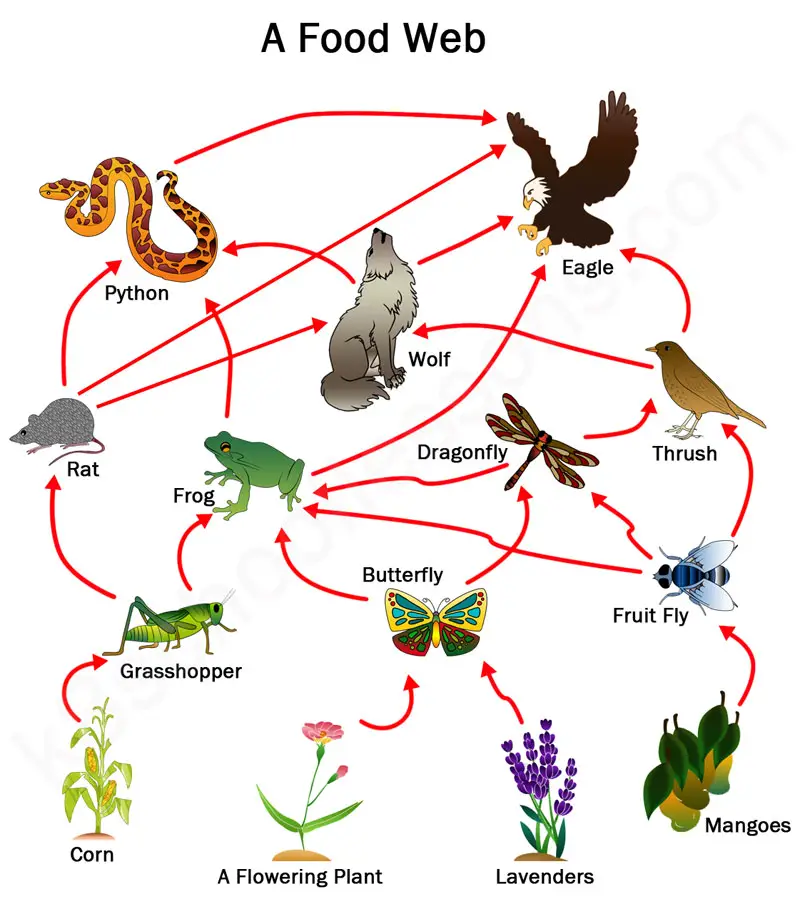
Types of Food Chain
There are two kinds of food chains: the one that starts with trash and the one that starts with grass. Let’s take a closer look at them:
1. Detritus food chain
- There are many different kinds of animals and plants in the detritus food chain, such as algae, bacteria, fungi, protozoa, mites, insects, worms, and so on.
- The first step in the detritus food chain is dead organic matter.
- Smaller organisms like carnivores eat the decomposers and detritivores, which get their energy from the food.
- Maggots are carnivores, and bigger carnivores like frogs, snakes, and so on eat them.
- Detritivores are organisms that feed on dead matter. These include fungi, bacteria, protozoans, and so on.
2. Grazing food chain
- The grazing food chain is a type of food chain that goes from green plants to herbivores to carnivores.
- In a food chain with grazing, the energy for the lowest level comes from photosynthesis.
- In this type of food chain, energy goes from plants to herbivores as the first step.
- The flow of energy from autotrophs to herbivores is what makes this type of food chain work.
- As autotrophs are the foundation of all ecosystems on Earth, this type of food chain is used by most ecosystems.
Length of Food Chain
- The length of a food chain is a continuous variable that shows how energy moves from the lowest to the highest trophic (feeding) level. It is also an indicator of the structure of an ecosystem.
- Ecological modelling often uses food chains (such as a three-species food chain). They are simplified versions of real food webs, but the way they work and the math behind them are complicated.
- Ecologists have made and tested hypotheses about the nature of ecological patterns related to food chain length. For example, they have thought that the length of a food chain increases with the size of an ecosystem, that energy decreases at each level, or that long food chains are unstable.
- Studies of the food chain are an important part of ecotoxicology studies, which look at how pollutants move through the environment and how they affect living things.
- Organisms that use energy from the sun or chemicals to make starch are called producers.
- Every chain of food has to start with a producer. In the deep sea, where there is no sunlight, food chains are built around hydrothermal vents and cold seeps.
- Chemosynthetic bacteria and archaea use hydrogen sulphide and methane from hydrothermal vents and cold seeps as an energy source, just like plants use sunlight, to make carbohydrates. They are at the bottom of the food chain.
- Organisms that eat other organisms are called consumers. The first organism in a food chain is the only one that doesn’t eat.
- The length of the food chain is important because the amount of energy passed from one trophic level to the next decreases as the number of trophic levels goes up. Usually, only 10 percent of the total energy at one trophic level is passed to the next because the rest is used in the metabolic process. In most food chains, there are no more than five trophic levels.
- People can get more energy by going back one level in the food chain and eating the food that came before. For example, a salad gives more energy per pound than lettuce did for an animal.
- How well a food chain works depends on how much energy the first producers need. The producer gives energy to the first consumer, who then gives it to the second and third consumers.
Grazing vs. detrital food webs
- Most food webs don’t show decomposers. You may have noticed that the food web above for Lake Ontario does not. Still, all ecosystems need ways to get rid of waste and dead things.
- So, decomposers are around, even if they don’t get much attention.
- In the meadow ecosystem shown below, for example, there is a grazing food web made up of plants and animals that feeds a detrital food web made up of bacteria, fungi, and detritovores.
- The brown band across the bottom of the diagram is a simplified version of the detrital web. In reality, it would be made up of different species connected by the way they eat, like the arrows in the grazing food web aboveground.
- When an earthworm is eaten by a robin, for example, it gives energy to a grazing food web.
Food Chain in a Terrestrial Ecosystem
- The sun is the most important source of energy, and plants use sunlight to make food through a process called photosynthesis.
- The next part is the animal or consumer that eats the plant from the level below.
- The consumer doesn’t make the food they eat or the energy they use. Instead, they eat plants to get the energy they need.
- Also, primary consumers are the organisms that eat the primary producers.
- Herbivores like cows, goats, people, etc. can be primary consumers in the terrestrial ecosystem.
- But when a person eats a plant-eating animal, they become a Secondary Consumer.
- As its levels go up, the amount of energy in it goes up, too. It’s easy to understand the trophic levels as:

Energy Transfer in the Food Chain
Even though a food chain is made up of many different kinds of living things, such as trees, plants, insects, mammals, and fish. Energy transfer in the food chain is the movement of energy from one organism to another. Energy is first taken in by the “producer,” which is usually a tree or plant that uses water and sunlight to get its energy. When an animal eats something from the part of the food chain before it, this energy is passed on to the next link in the chain. This transfer of energy keeps going all the way to the end of the food chain.
Energy Transfer In Action
A snail like the Giant African Land Snail (Achatina Fulica) is a primary consumer. It eats plants and leaves, which are primary producers. The Land Snail will then get energy from the plants it eats. Over time, this primary producer may be eaten by a secondary consumer, like a bird or mammal, and the flow of energy will continue.
Energy Loss
During energy transfer in the food chain, about 90% of the energy that could be used is lost. Only 10% of the energy that is available is passed on to the next level. The rest of the energy leaves the food chain in one of several ways:
- It is used to make heat.
- It helps keep life going (movement).
- Waste from animals and plants.
Since energy is lost when energy is passed along the food chain, The number of links and levels in an ecosystem can only go up to a certain point. It also means that animals at the top of the food chain need to eat and drink more to stay healthy.
Food Chain Examples
Different ecosystems will have different food chains. Let’s look at some examples of the food chain:
Food Chain in a forest
In a forest ecosystem, plants and trees are the ones that make things. A deer eats plants, while a carnivore like a tiger eats a deer.
Plants —> Deer —> Tiger
Food Chain in a grassland
In a grassland ecosystem, sunlight is used by the grass to make its own food. Grasshoppers eat grass, while frogs eat grasshoppers. The chain continues with a snake eating a frog and an eagle eating a snake.
Grass —> Grasshopper —> Frog —> Snake —> Eagle
Food Chain in a pond
Algae or water plants can be the producers in a pond ecosystem. Small insects or fish eat these plants and algae. Large fish eat these small insects or fish. Then, birds or animals that eat fish will eat big fish, creating a chain.
Algae —> Small Fishes —> large Fishes —> Fish Eating Birds
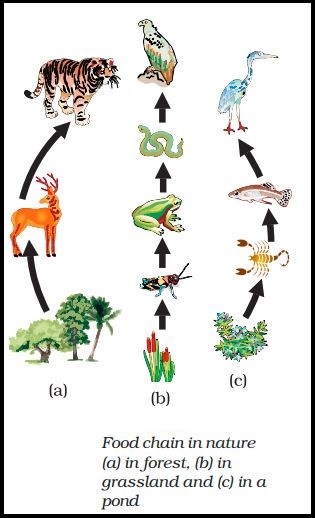
Key points
- Autotrophs are living things that make their own organic molecules. Heterotrophs, which eat other organisms, get their organic molecules from the food they eat.
- A food chain is a line of organisms where nutrients and energy move from one to the next as one eats the other.
- In a food chain, each organism is at a different trophic level, which is determined by how many energy transfers separate it from the starting point of the chain.
- Food webs are more accurate pictures of how organisms eat in ecosystems because they show how many food chains are connected to each other.
- The average efficiency of energy transfer between trophic levels is around 10%. Because of this inefficiency, food chains can only be so long.
References
- Strong, D. R. (2008). Food Chains and Food Webs. Encyclopedia of Ecology, 1627–1636. doi:10.1016/b978-008045405-4.00497-3
- https://education.nationalgeographic.org/resource/food-chain
- https://www.khanacademy.org/science/ap-biology/ecology-ap/energy-flow-through-ecosystems/a/food-chains-food-webs
- https://www2.nau.edu/lrm22/lessons/food_chain/food_chain.html
- https://wwf.panda.org/discover/knowledge_hub/teacher_resources/webfieldtrips/food_chains/
- https://www.toppr.com/guides/biology/ecosystem/food-chain-and-food-web/
- https://www.sheppardsoftware.com/content/animals/kidscorner/foodchain/foodchain.htm
- https://www.twinkl.co.in/teaching-wiki/food-chain
- https://flexbooks.ck12.org/cbook/ck-12-biology-flexbook-2.0/section/6.3/primary/lesson/food-chains-and-food-webs-bio/
- https://www.mpalalive.org/classroom/lesson/food-chains-kenya
- https://www.ducksters.com/science/ecosystems/food_chain_and_web.php
- https://www.embibe.com/exams/food-chain/
- https://ib.bioninja.com.au/standard-level/topic-4-ecology/42-energy-flow/food-webs.html
- https://www.epa.gov/sites/default/files/documents/foodchainsandfoodwebs.pdf
- https://www.vedantu.com/biology/overview-of-food-chain
- https://www.britannica.com/science/food-chain
- https://en.wikipedia.org/wiki/Food_chain
